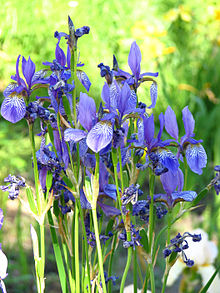
Iris ser. Longipetalae is a series of the genus Iris, in Iris subg. Limniris.

Iris sibirica, is a species in the genus Iris. It is a rhizomatous herbaceous perennial, from Europe and Central Asia. It has long green grass-like leaves, tall stem, 2–5 violet-blue, to blue, and occasionally white flowers. It is cultivated as an ornamental plant in temperate regions.

Iris chrysographes, the black iris, is a plant species that belongs to the genus Iris. It is native to Southern China and Myanmar (Burma), growing in meadows, streamsides, hillsides and forest margins.
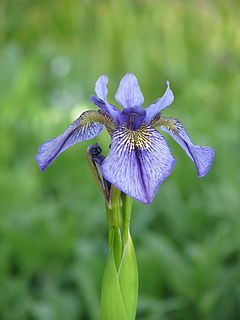
Iris delavayi is a species of flowering plant in the subgenus Limniris and in the series Sibiricae of the family Iridaceae. This rhizomatous herbaceous perennial comes from various provinces in China. It has grey-green leaves, long hollow stem, and 2 flowers in various blue shades. From dark violet, dark purple, purple-blue, dark blue to light purple. It is cultivated as an ornamental plant in temperate regions.

Iris sanguinea is a rhizomatous flowering plant in the genus Iris and in the series Sibiricae. It is cultivated as an ornamental plant in temperate regions. It is one of the species considered a Japanese iris. It is from Asia, found between Russia, Mongolia, China, Japan and Korea. It has grey green leaves, an unbranched flowering stem and flowers in reddish-purple shades, from blue to blue-purple, red-violet, with a rare white variant.
William Rickatson Dykes was an English amateur botanist who became an expert in the field of iris breeding and wrote several influential books on the subject. He was also interested in tulips, amaryllis, and other plants.
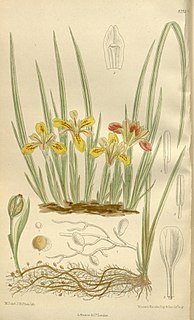
Iris ser. Chinenses is a series of the genus Iris, in Iris subg. Limniris.

Iris ser. Laevigatae is a series of the genus Iris, in Iris subg. Limniris.

Iris series Spuriae are a series of the genus Iris, in Iris subg. Limniris. They are sometimes commonly known as butterfly irises.

Iris ser. Tripetalae is a series of the genus Iris, in Iris subg. Limniris.

Iris bulleyana is a species in the genus Iris, also the subgenus Limniris and in the series Sibiricae. It is a rhizomatous herbaceous perennial, from South west China, including Myanmar and Tibet. It has long thin green leaves,
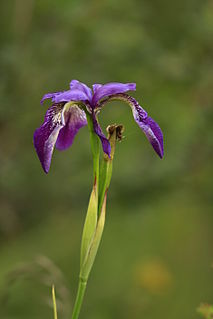
Iris clarkei is a species in the genus Iris, also the subgenus of Limniris and in the series Sibiricae. It is a rhizomatous herbaceous perennial, from Asia, including north east India, Nepal, Tibet, Bhutan, Burma and in China. It has grey-green leaves, long and thin green stem and violet, to dark blue, to blue or reddish purple flowers.
Iris forrestii is a species of flowering plant in the genus Iris, also the subgenus Limniris and in the series Sibiricae. It is a rhizomatous herbaceous perennial, from China and Burma. It has linear grassy-like leaves, long thin stem and fragrant yellow or lemon-yellow flowers. It is cultivated as an ornamental plant in temperate regions.

Iris typhifolia is a species in the genus Iris, also the subgenus Limniris and in the series Sibiricae. It is a rhizomatous herbaceous perennial, from China. It has slender, twisted leaves, deep green slender hollow stem and 2 violet-blue flowers. It is cultivated as an ornamental plant in temperate regions.

Iris wilsonii is a species of flowering plant in the family Iridaceae, native to China. It is placed in the series Sibiricae of the subgenus Limniris of the genus Iris. This rhizomatous herbaceous perennial has long and drooping grey-green leaves, hollow stems and two fragrant yellow, pale yellow or yellow/white flowers.
Iris ludwigii, with the common name Ludwig iris, is a species in the genus Iris. It is also in the subgenus Iris subg. Limniris and in the series Spuriae. It is a rhizomatous perennial plant with violet-blue flowers. It is native to the Altai Mountains in Central Asia, where Russia, China, Mongolia, and Kazakhstan meet. It is cultivated as an ornamental plant in temperate regions.

Iris spuria subsp. maritima is a species of the genus Iris, part of a subgenus series known as Iris subg. Limniris and in the series Iris ser. Spuriae. It is a subspecies of Iris spuria, a beardless, rhizomatous perennial plant, from coastal regions Europe and north Africa with deep blue-violet flowers.
Iris bloudowii is a species in the genus Iris, it is also in the subgenus of Iris and in the Psammiris section. It is a rhizomatous perennial, from Russia, Siberia, Kazakhstan, Mongolia and China, with sickle-shaped leaves, slender stem and 2 bright or pale yellow flowers. It is cultivated as an ornamental plant in temperate regions.
Iris cuniculiformis is a plant species in the genus Iris, it is also in the subgenus Iris and in the section Pseudoregelia. It is a rhizomatous perennial, from China, it has long and thin green leaves, and 1 lilac large flowers, that have yellow or grey beards. It is cultivated as an ornamental plant in temperate regions.
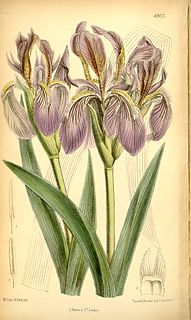
Iris scariosa is a plant species in the genus Iris, it is also in the subgenus Iris. It is a rhizomatous perennial, from the mountainsides of Russia, Kazakhstan, Mongolia and China. It has sword-like, or sickle shaped, blue green or grey-green leaves, a short flowering stem, 3 or 4 membranous or semi-transparent flower bud leaves, 2 violet, reddish violet, lilac, blue-purple, or blue flowers in late spring, with yellow or white beards. It is cultivated as an ornamental plant in temperate regions. It was merged with another similar iris in the region, and Iris glaucescens became a synonym of Iris scariosa, before being divided into two separate species again. Although some sources still call it the main species, despite a slight colour difference.
